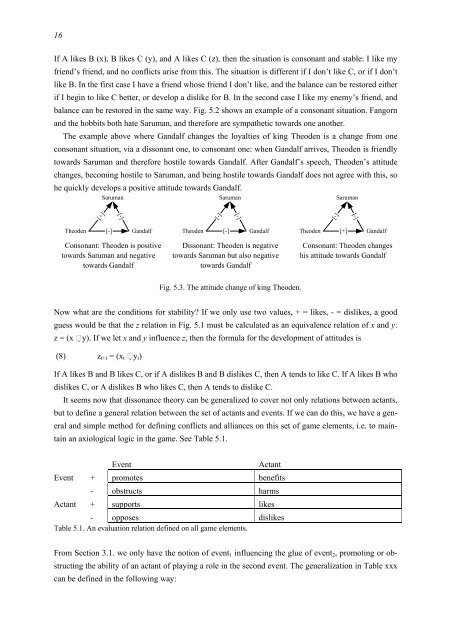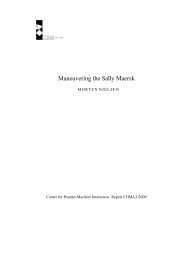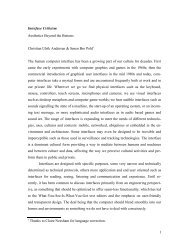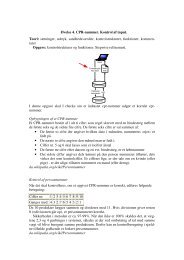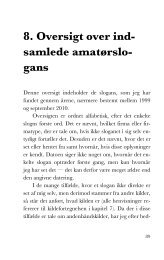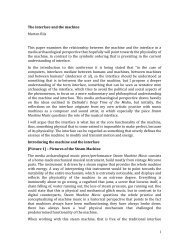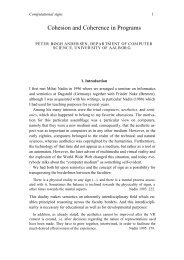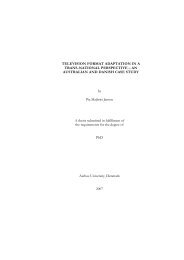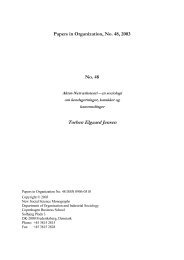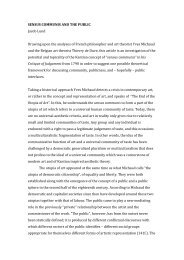Interaction and narration. Tearing Tolkien apart - CiteSeerX
Interaction and narration. Tearing Tolkien apart - CiteSeerX
Interaction and narration. Tearing Tolkien apart - CiteSeerX
Create successful ePaper yourself
Turn your PDF publications into a flip-book with our unique Google optimized e-Paper software.
[+]<br />
[-]<br />
[-]<br />
[-]<br />
[-]<br />
[-]<br />
16<br />
If A likes B (x), B likes C (y), <strong>and</strong> A likes C (z), then the situation is consonant <strong>and</strong> stable: I like my<br />
friend’s friend, <strong>and</strong> no conflicts arise from this. The situation is different if I don’t like C, or if I don’t<br />
like B. In the first case I have a friend whose friend I don’t like, <strong>and</strong> the balance can be restored either<br />
if I begin to like C better, or develop a dislike for B. In the second case I like my enemy’s friend, <strong>and</strong><br />
balance can be restored in the same way. Fig. 5.2 shows an example of a consonant situation. Fangorn<br />
<strong>and</strong> the hobbits both hate Saruman, <strong>and</strong> therefore are sympathetic towards one another.<br />
The example above where G<strong>and</strong>alf changes the loyalties of king Theoden is a change from one<br />
consonant situation, via a dissonant one, to consonant one: when G<strong>and</strong>alf arrives, Theoden is friendly<br />
towards Saruman <strong>and</strong> therefore hostile towards G<strong>and</strong>alf. After G<strong>and</strong>alf’s speech, Theoden’s attitude<br />
changes, becoming hostile to Saruman, <strong>and</strong> being hostile towards G<strong>and</strong>alf does not agree with this, so<br />
he quickly develops a positive attitude towards G<strong>and</strong>alf.<br />
Saruman<br />
Saruman<br />
Saruman<br />
Theoden<br />
[-]<br />
G<strong>and</strong>alf<br />
Theoden<br />
[-]<br />
G<strong>and</strong>alf<br />
Theoden<br />
[+]<br />
G<strong>and</strong>alf<br />
Consonant: Theoden is positive<br />
towards Saruman <strong>and</strong> negative<br />
towards G<strong>and</strong>alf<br />
Dissonant: Theoden is negative<br />
towards Saruman but also negative<br />
towards G<strong>and</strong>alf<br />
Consonant: Theoden changes<br />
his attitude towards G<strong>and</strong>alf<br />
Fig. 5.3. The attitude change of king Theoden.<br />
Now what are the conditions for stability? If we only use two values, + = likes, - = dislikes, a good<br />
guess would be that the z relation in Fig. 5.1 must be calculated as an equivalence relation of x <strong>and</strong> y:<br />
z = (x y). If we let x <strong>and</strong> y influence z, then the formula for the development of attitudes is<br />
(8) z t+1 = (x t y t )<br />
If A likes B <strong>and</strong> B likes C, or if A dislikes B <strong>and</strong> B dislikes C, then A tends to like C. If A likes B who<br />
dislikes C, or A dislikes B who likes C, then A tends to dislike C.<br />
It seems now that dissonance theory can be generalized to cover not only relations between actants,<br />
but to define a general relation between the set of actants <strong>and</strong> events. If we can do this, we have a general<br />
<strong>and</strong> simple method for defining conflicts <strong>and</strong> alliances on this set of game elements, i.e. to maintain<br />
an axiological logic in the game. See Table 5.1.<br />
Event<br />
Actant<br />
Event<br />
Actant<br />
+ promotes benefits<br />
- obstructs harms<br />
+ supports likes<br />
- opposes dislikes<br />
Table 5.1. An evaluation relation defined on all game elements.<br />
From Section 3.1. we only have the notion of event 1 influencing the glue of event 2 , promoting or obstructing<br />
the ability of an actant of playing a role in the second event. The generalization in Table xxx<br />
can be defined in the following way:


